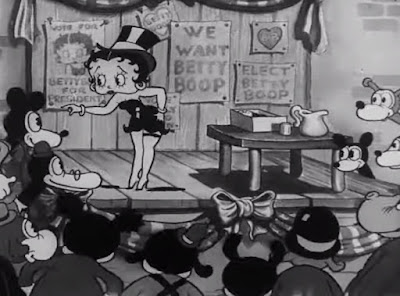Palooka (1934) (aka "Joe Palooka")
Starring: Jimmy Durante, Stuart Erwin, Lupe Velez, Marjorie Rambeau, William Cagney, Tom Dugan, Mary Carlisle, Robert Armstrong. and Thelma Todd
Director: Benjamin Stoloff
Rating: Five of Ten Stars
Joe Palooka (Erwin), the goodhearted and terminally naive son of a legendary, retired boxer (Armstrong) is catapulted to the top of the boxing world through happenstance and the shenanigans of his shady manager and promoter, Knobby Walsh (Durante). When a sexy vamp (Velez) tempts him to party instead of train, and the true champion he defeated more through luck than skill (Cagney) engineers a rematch, things start to look pretty grim for Joe...
During the 1930s and 1940s, the "Joe Palooka" newspaper strip grew to become the most popular in the U.S. Debuting in April of 1930, it ran for almost 55 years with the final installment seeing print in November of 1984. There were several film adaptations made of the strip, of which this was the first, so it's fitting that it's an "origin tale".
Sadly, Joe Palooka (affably played by Stuart Erwin) is almost crowded out of his own movie by his manager Knobby Walsh (obnoxiously played by Jimmy Durante). All in all, this film is more a vehicle for Durante than anything else, even to the point where he even gets to ruin the film's ending with one last, incredibly lame gag.
I confess that it's a mystery to me that Durante had a long career headlining anything. He's funny in small doses, but when he gets as much screentime as he does here, he gets very,
very tiresome. His dominance of this picture turns it from what could have been a pleasant little sports picture into a grating festival of pain where I found myself rooting for the "villains" (prime among them being William Cagney's Al McSwatt, and Lupe Velez's slutty, gold-digging boxing groupie) just so I could enjoy some illusion of justice being served for Durante's crimes against humanity in this picture.
As for the rest of the cast, they're all pleasant and fun to watch. The aforementioned Stuart Erwin is likable as the title character, while William Cagney is one of the more charming bad guys you're ever likely to come across in a film. One the feminine front, Marjorie Rambeau is great as Joe Palooka's tough-as-nails retired showgirl mother, while Lupe Velez is fun, as well as getting some great lines, as the career-wrecking temptress. (Guys in the audience will also appreciate a couple of gowns Velez wears that would be falling off her if not for double-sided tape. Velez obviously didn't appreciate, or perhaps trust, one of the dresses, since she was constantly figiting with it.)
Robert Armstrong and Thelma Todd have small, but crucial, roles in the film (as Joe Palooka's father and the hussy who broke up his parents' marriage), and they deliver their usual strong performances. In fact, I liked Todd so much in her small role that I wish she and Velez could have swapped parts and characters. (This is probably just a reflection of my affection for Todd as a performer, as well as my unfamiliarity with the "Palooka" comic strip.)
"Palooka" is not a film I think you should go out of your way for, unless you're a Jimmy Durante fan. It may be entertaining if you have fond memories of the comic strip, or if perhaps you simply can't get enough of sports-themed movies, but the overwhelming presence of Durante taints those aspects of the film... and there are better movies about the smalltown-boy-does-good-in-sports that are more worthy of your time.




































.jpg)






.jpg)
